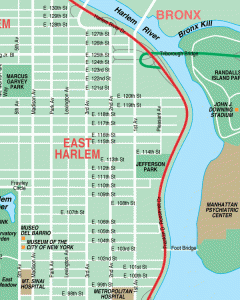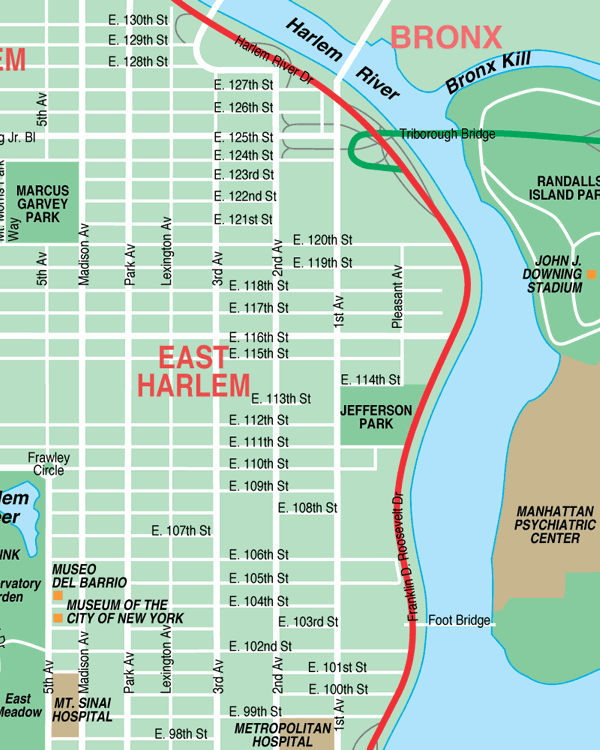 Traditionally, East Harlem has been an evolving community. Initially it was populated by German, Irish, Italian and Jewish immigrants, but there are reports going back to the 1930s of a sizable Hispanic community in East Harlem predominantly Puerto Rican. Now there is a booming Mexican and Salvadorean population, a growing number of Asians, and Caucasians moving to the area. While the neighborhood has been a destination for many people, it has remained largely Latino and throughout the world it is known as “El Barrio”. As New York City continues to grow, tensions have arisen in many neighborhoods between longtime residents and newer residents and the issue of gentrification.
Traditionally, East Harlem has been an evolving community. Initially it was populated by German, Irish, Italian and Jewish immigrants, but there are reports going back to the 1930s of a sizable Hispanic community in East Harlem predominantly Puerto Rican. Now there is a booming Mexican and Salvadorean population, a growing number of Asians, and Caucasians moving to the area. While the neighborhood has been a destination for many people, it has remained largely Latino and throughout the world it is known as “El Barrio”. As New York City continues to grow, tensions have arisen in many neighborhoods between longtime residents and newer residents and the issue of gentrification.
Gentrification is the common term used to describe newer more affluent residents moving into a less desirable area and changing the neighborhood. That change causes longtime residents to move out because of a variety of factors including unaffordability, pressure from property owners, diminishing or lack of stores that cater to them and many more. The issue is huge but one that has many layers and perspectives that can get lost or lack enough attention in the media. There have been documentaries about the subject and series in many publications pertaining to the issue. The “El Barrio Tours” documentary documents the issue and its effect in the East Harlem neighborhood also known as “Spanish Harlem”. The creator of the film, Andrew Padilla speaks to TheSource.com about his documentary and the issues of gentrification in East Harlem.
Why did you make the documentary?
The East Harlem community has it problems but there was and is a sense of community. As a child I didn’t understand race. I would be on the train and 96th Street was like the last stop for Caucasians unless there was a Yankees game. (It wasn’t a blatant rule that 96th street was the last stop but it was something that was common knowledge among transit riders) As I researched more of the economic reasons, social reasons for this phenomenon and it all boiled down to gentrification. The documentary was needed to connect the micro issues to the macro issues of gentrification. My research has also showed me that it is a global issue and if we understand those implications, we are less going to make the same mistakes in terms of how the issue is handled.
What is the difference in East Harlem then and now?
New York as a tourism capital is a conscious economic choice. There are many articles in the media about people moving to East Harlem. The media pushes gentrification. There are stories about the One Museum Mile building, a new building with an African museum part of it, but the African museum is not built up. That building was in the newspapers for years, there was advertising for it in the New York Times, New York Daily News. I feel the same way about the Lower East Side and how MTV pushed gentrification in that area. Their coverage pushed new residents to come into the area.
One issue that has emerged in the whole gentrification saga is changing the names of neighborhoods. What is the effect of that?
That’s another way to raise the value of property. Real estate companies try changing the names like using Upper Yorkville, Spaha or expanding the border of the Upper East Side district to cover the area. For marketing purposes, when you search East Harlem and the Bronx, some bad pictures show up. So changing the names of neighborhood allows realtors not having to explain that issue.
How long did it take you to create the documentary?
It took me three months to shoot the footage and a year of pickup interviews and getting the film to the public. The documentary was real hard to screen in New York. I didn’t have film contacts and organizations that I thought that would support the project didn’t. If you understand the non-profit world and donor relations, screening this documentary could cause some problems. Luckily, I got Hunter College to premiere it, and they helped promote it. Other community groups like East Harlem Preservation helped as well. The issue of gentrification is not like stop and frisk, there are organizing problems with it.
The issue of gentrification tends to get bogged down in arguments between the new and local residents. One of those underlying issues is race. Can you explain that dynamic?
The issue tends to get bogged down in race because it’s the easiest to see and because in some instances the two populations (white and non-white) get treated differently. Some landlords are pushing out residents even those with diverse tenant associations. I interviewed one of these associations and everyone understood the issue at hand with the landlord wanting everyone out. The residents of that building made it more palatable to live and then the newer residents move in. Gentrification is great if you are a property owner, but the small owners get killed in taxes. The renters known their rents are going up. I had a conversation with a person who admitted to me they were a gentrifier, but I explained to them that just because you pay more now, doesn’t mean you won’t get pushed out later. You aren’t naturally good because you have been in the neighborhood all your life, and you aren’t naturally bad because you just moved in. It’s your commitment to the neighborhood that determines that.
What is the latest news happening with the documentary?
I am screening the film across the country. I have plans to shoot a documentary about the subject of gentrification nationally. I feel there is a way to connect these issues nationally and to talk about the economic and community issues regarding the topic. In terms of availability of the film, it will be available for purchase soon. But I want it to be accessible, and I want people to be engaged on the topic.
An issue not talked about enough in the whole gentrification saga is the issue of local ownership and neighborhood notoriety artists tend to bring to underserved communities. Can you explain that issue?
Building owners usually stop artists from having art studios, so some buildings have beautiful art and murals on them. The tragedy of an artist is to make a neighborhood so beautiful that they themselves cannot live there. Neighborhood notoriety affects existing businesses in the area as well. Small businesses have no protection. For example, on one commercial strip in East Harlem, five businesses got kicked out in the span of 30 days. The landlord wanted more rent and made it hard on them and that’s an endemic problem. East Harlem is full of culture and there is also Central Harlem and the whole Harlem Renaissance that people created. You may have their pictures in a café, but the residents no longer live there. The people outside the neighborhood are benefiting from gentrification. Gentrification is a slow process. Even in East Harlem, there are businesses that got kicked out a year ago and the landlord can’t push market rate rents but the strip is half-dead. When we say a neighborhood is revitalized, it means it was dead and that brings in the question did it die a natural death or was it done intentionally. There is nothing wrong with incentivizing outsiders, but how about pushing small businesses already in the neighborhood to expand and hire in the community.
The issue of gentrification is a global issue. One place where there are similarities is in Paris and this issue of gentrification and new residents moving into the area is called the “bobo” movement. That movement which started in the 1970s has led to Paris’s center being for the moneyed elite and everyone else being pushed outside to the margins. There have been assumptions by some people that if people continue to get pushed out of the city center Can you talk about the global issues concerning gentrification and the prospects of a New York City resembling Paris, London and other global capital centers?
That’s the direction we are headed in. I believe we are 10-20 years away from that. Gentrification comes in waves, right now we are experiencing the first, second, and third wave, but there is a fourth, fifth, and sixth wave coming. It should be said there is nothing wrong with wealth, but its intentional city planning decisions that leads to this. A lot of times, plans for a neighborhood are done years prior. Urban planning are decisions for the long term and no one from our communities are making these decisions.
There was a controversial proposal by the New York City Housing Authority titled Land-Lease which would essentially allow high rises to be built on NYCHA and the taxes from that would be used to help alleviate the budget issues the agency was facing. Can you talk about your views on the program?
There is no doubt NYCHA needs repairs. Public housing has been demolished in Chicago, Louisiana and in Newark, NJ. 620,000 people live in NYC public housing. I didn’t think it was a good idea. This land-lease project would cause a lot of problems. The numbers that NYCHA put out wouldn’t fix the problems. Public housing is in debt because it was abandoned. The dialogue of the land-lease project was using vacant underutilized land, but the public schools use the parks in public housing as well. There was a demonization of residents of public housing. One issue that NYCHA should deal with is NYC public housing residents paying for police protection twice. They also pay for their own sanitation. The residents were not brought to the table, they were told about the idea.
What do you see happening in East Harlem ten years from now?
I don’t have a magic ball, but if we keep on this path, we are going to have less longtime residents stay in this area, more of the middle class will leave and the city will continue to be more inequitable. The community needs to have a seat at the table. New businesses and old businesses need to be able to co-exist in the area. One good example is a butcher shop owner in the 1970s started bought land and started rehabbing vacant lots and got money from the city to build affordable housing and rented to community residents and to local businesses. That’s the main thing, I hope to see. We need to get active. Politics runs on financial power and people power. We shouldn’t sit back, after an election is won a commitment is made. The community has to push and push, we can’t depend on elected officials, and the will has to come from us.
To support El Barrio Tours fundraising efforts, you can make a donation at their GoFundMe.com page.
-Written by Lulaine C.
